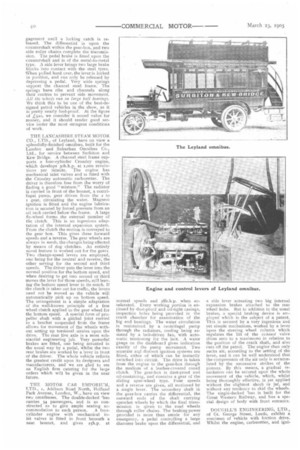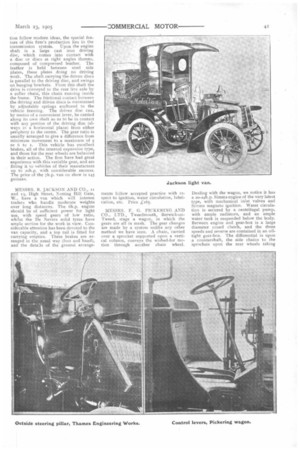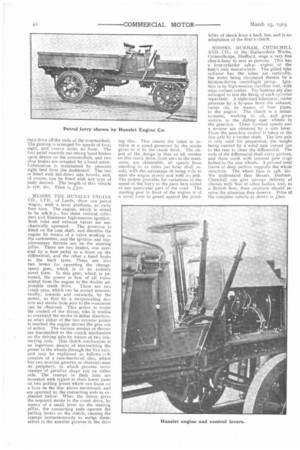Petrol Vehicles at the Show.
Page 15

Page 16

Page 17

Page 18

If you've noticed an error in this article please click here to report it so we can fix it.
MESSRS. H. M. HOBSON, LTD., of Sc, King's Road, S.W., show the Decauvine delivery van. The pressed steel framework gives ample length for the body, and supports a 12-i6h.p. four-cylinder engine with M.O. inlet valves. The gear-box is cast as an extension of the crank chamber, and provides for three forward speeds (direct drive on top) and a reverse. The coned clutch between engine and gear-box is leather lined, and ia so arranged that the end thrust is not transferred to any other part of the driving mechanism. Between the gear-box and differential upon the live axle is the cardan shaft, which has an universal joint at either end. The live axle is a special feature upon this vehicle, as the Decauvine originated a system (now very generally copied) whereby the driving axle is used only for that purpose, the weight being supported by the outer sleeve and a special arrangement of the outside ends of the driving axle and sleeve respectively. For engine cooling a beehive or cellular radiator is employed, in which is combined the water tank, having at its rear a belt-driven fan. The foot brake connects to a drum upon the differential, and the two rear brakes are worked by a side lever. The price, as exhibited, is Z45o.
MESSRS. THE N.A.G. AUTOMOBILE CO., LTD., of 107, Great Portland Street, W., show one lorry. This has a two-cylinder, ish.p. engine, with mechanical inlet valves. The exhaust and inlet valve chambers are on opposite sides, and the valves are made quickly accessible by the removal of one nut off the dog clamp over either pair of valves. The two cylinders are a single casting and are secured to the crank chamber by six bolts. Very ample water jacketing is given ; the gear-driven centrifugal pump circulates the water through a radiator, which is distinctive in shape and possesses several interesting features. The tank surrounds the radiator ; on the front of the tank is a ring, held in place by a number of bons and nuts. The ring is just the thickness of the tank, plus the thickness of the exterior. Through this ring, top and bottom, are pierced a num tier of holes, into which are beaded a corresponding number of weldless steel tubes of about 3-16 of an inch internal diameter. These tubes are some 65o in number and have a total length of a little over r,000ft. The tubes pass through seven fins between top and base of the ring, and are not soldered to the fins but only to the carrying ring. In the event of breakage or stopping up of a tube it is an easy matter to withdraw the ring and the tubes bodily and simply unsolder the faulty one. A belt-driven fan is behind the radiator, and as its periphery coincides with the diameter of the holding ring, the air must of necessity be drawn past every tube. It is a clever system, and we should surmise that overheating would be impossible. For the ignition a low-tension, gear-driven magneto is employed, the tappets for the make and
break being actuated off the inlet valve cam shaft. A float-feed spray carburetter is fed with petrol from a tank having a capacity for 65 to 95 miles, according to the nature of the roads covered. The engine is lubricated from an exhaustpressure feed oil box. The clutch differs from the normal type ; it has a leather face, but is expanded internally against the large fly-wheel. The clutch pedal can be held down out of action by a neat holder on the footboard, and this is useful for traffic work, as the governor is purposely disconnected until the clutch is taken out. Four speeds and a reverse are controlled by a lever upon the steering column. We are glad to notice this, and believe it to be better than a side changespeed lever for van and wagon work. This lever has a neutral between each speed, and the reverse cannot be put into en gagernent until a locking catch is released. The differential is upon the countershaft within the gear-box, and two side roller chains complete the transmission. The pedal brake is fitted upon the countershaft and is of the metal-to-metal type. A side lever brings two large brake blocks into contact with the steel tyres. When pulled hard over, the lever is locked in position, and can only be released by depressing a pedal. Very wide springs support the channel steel frame. The springs have ribs and channels along their centres to prevent side movement. All tne wheels run on large ball bearings. We think this to be one of the best-designed petrol vehicles in the show, as it is pretty nearly fool-proof. At the figure of L5.2o, we consider it sound value for money, and it should render good service under the most stringent conditions of work.
THE LANCASHIRE STEAM MOTOR CO., LTD., of Leyland, have on view a splendidly-finished omnibus, built for the London and Suburban Omnibus Co., Ltd., for service between Surbiton and Kew Bridge. A channel steel frame supports a four-cylinder Crossley engine, which develops 3ob.h.p. at i,000 revolutions per minute. The engine has mechanical inlet valves and is fitted with the Crossley automatic carburetter. The driver is therefore free from the worry of finding a good "mixture." The radiator is carried in front of the bonnet, a centrifugal pump, gear driven from the 2 to I gear, circulating the water. Magneto ignition is fitted and the engine lubrication is secured by forced pressure from an oil tank carried below the frame. A large fly-wheel forms the external member of the clutch. This is an ingenious adaptation of the internal expansion system. From the clutch the motion is conveyed to the gear box. This gives three forward speeds and a reverse. The gear wheels are always in mesh, the changes being effected by means of dog clutches_ An entirely novel feature is worked out for the gears. Two change-speed levers are employed, one being for the neutral and reverse, the other serving for the second and third speeds. The driver puts the lever into the normal position for the bottom speed, and when desiring to get into second or third moves the lever for those speeds, still leaving the bottom speed lever in its notch. If the clutch is taken out for traffic, the levers need not be moved as the vehicle will automatically pick up on bottom speed. The arrangement is a simple adaptation of the well-known principle of a free wheel clutch applied to the gear wheel for the bottom speed. A special form of propeller shaft with a gimbal joint carried in a bracket suspended from the frame allows for movement of the wheels without setting up torsional strains upon the drive. The rear live axle is a most substantial engineering join Very powerful brakes are fitted, one being actuated in the usual way by a pedal, whilst the twe rear brakes are worked by a lever in front of the driver. The whole vehicle reflects the greatest credit upon its designers and manufacturers, and we are glad to see an English firm catering for the large orders which will be given in the near future.
THE MOTOR CAR EMPORIUM, LTD., s, Addison Road North, Holland Park Avenue, London, W., have on view two omnibuses. The double-decked 'bus carries 34 passengers, and is so constructed as to give ample seating accommodation to each person. A four. cylinderengine with mechanical inlet valves is fitted in front beneath a neat bonnet, and gives 25h.p. at normal speeds and 28b.h.p. when accelerated. Every working portion is enclosed by dust-proof and oil-tight casings, inspection holes being provided in the crank chamber for examination of the big end bearings. The water circulation is maintained by a centrifugal pump through the radiators, cooling being assisted by a belt-driven fan, with automatic tensioning for the belt, A water gauge on the dashboard gives indication exactly of the pump movement. Two separate anel distinct ignition systems are fitted, either of which can be instantly switched into circuit. The drive is taken from the engine to the gear-box through the medium cif a leather-covered coned clutch. The gear-box is dust-proof and oil-containing, and contains a gear of the sliding spur-wheel type. Four speeds and a reverse are given, MI motioned by a single lever. The secondary shaft in the gear-box carries the differential, the outward ends of the shaft carrying sprocket wheels by which the final transmission is given to the road wheels through roller chains. The braking power provided is more than ample for any emergency, a pedal controlling a large diameter brake upon the differential, and a side lever actuating two big internal expansion brakes attached to the rear wheel hubs. But in addition to the usual brakes, a special braking device is employed which is the subject of a patent. This is secured by a very ingenious and yet simple mechanism, worked by a lever upon the steering wheel column which regulates the lift of the exhaust valve (from zero to a maximum) in relation to the position of the crank shaft, and also cuts off the petrol. The engine then only sucks air, according to the setting of the lever, and it can be well understood that the compression of the air only is accumulated by the successive strokes of the pistons. By this means, a gradual retardation can be secured upon the whole movement of the vehicle, which, whilst being thoroughly effective, is yet applied without the slightest shock or jar, and without any tendency to skid the wheels. The single-decked 'bus is built for the Great Western Railway, and has a special design of body with front entrance.
DOITGILL'S ENGINEERING, LTD., of Gt. George Street, Leeds, exhibit a specimen of vehicle with friction drive. Whilst the engine, carburetter, and igni
tion follow modern ideas, the special feature of this firm's production lies in the transmission system. Upon the engine shaft is a large cast iron driving disc, which comes into contact with a disc or discs at right angles thereto, composed of compressed leather. The leather is held between steel side plates, these plates doing no driving work. The shaft carrying the driven discs is parallel to the driving disc, and swings on hanging brackets. From this shaft the drive is conveyed to the rear live axle by a roller chain, this chain running inside the frame. The frictional contact between the driving and driven discs is maintained by adjustable springs anchored to the vehicle framing. The driven disc can, by means of a convenient lever, he carried along its own shaft so as to be in contact with any portion of the driving disc (always in a horizontal plane) from either periphery to the centre. The gear ratio is usually arranged to give a difference from minimum movement to a maximum of 5 or 6 to I. This vehicle has excellent brakes, all of the internal expansion type, and those for the rear wheels are balanced in their action. The firm have had great experience with this variable gear, and are fitting it to vehicles of their manufacture up to zoh.p. with considerable success. The price of the 7h.p. van on show is 145 guineas.
MESSRS. R. JACKSON AND CO., x x and re, High Street, Notting Hill Gate, W., have a van which will interest traders who handle moderate weights over long distances. The 6h.p. engine should be of sufficient power for light use, with speed gears of low ratio, whilst the De Nevers solid tyres have ample section for the work in view. Considerable attention has been devoted to the van capacity, and a top rail is fitted for carrying empties. Three brakes are arranged in the usual way (foot and hand), and the detalls of the general arrange. ments follow accepted practice with respect to ignition, water circulation, lubri• cation, etc. Price Z:165.
MESSRS. F. 0. PICKERING AND CO., LTD., Tweedmouth, Berwick-on. Tweed, stage a wagon, in which the gears are all in mesh. The gear changes are made by a system unlike any other method we have seen. A chain, carried over a sprocket supported upon a vertical column, conveys the wished-for motion through another chain wheel. Dealing with the wagon, we notice it has a 2o-24h.p. Simms engine of the very latest type, with mechanical inlet valves and Simms magneto ignition. Water circulation is secured by a centrifugal pump, with ample radiators, and an ample water tank is suspended below the body. Between engine and gear-box is a large diameter coned clutch, and the three speeds and reverse are contained in an oil. tight gear-box. The differential is upon a countershaft, the side chains to the sprockets upon the rear wheels taking
their drive off the ends of the countershaft. The gearing is arranged for speeds of four, eight, and twelve miles an hour. The foot pedal controls iwo strong band brakes upon drums on the countershaft, and two shoe brakes are actuated by a hand screw. Lubrication is maintained by pressure sight feed from the dashboard. The van is fitted with fall-down side hoards, and, of course, can be fitted with any type of body desired. The length of this vehicle is z7ft. bin. Price is )c.520.
MESSRS. TIIE HUNSLET ENGINE CO., LTD., of Leeds, show one petrol wagon, with a level platform, to carry four tons. The engine, which is stated to be zob.h.p., has three vertical cylinders and Eisemann high-tension ignition. Both inlet and exhaust valves are me chanically operated. The governor is fitted on the cam shaft, and throttles the engine by means of a valve working in the carburetter, and the ignition and supplementary throttle are on the steering pillar. There are two brakes, one operated by a foot pedal to a drum on the differential, and the other a hand brake to the back tyres. There are also two levers for operating the change. speed gear, which is of an entirely novel form. In this gear, which is patented, the power is first of all transmitted from the engine to the double ad
justable crank drive. There are two crank pins, which can be moved automatically, inwards and outwards, by the motor, so that by a reciprocating motion any stroke from zero to the maximum can be obtained. This action is under the control of the driver, who is unable to overwind the stroke in either direction, as when either of the two extreme points is reached the engine throws the gear out of action. The various strokes or throws are transmitted to the clutch mechanism on the driving axle by means of two connecting rods. This clutch mechanism is an ingenious means of transmitting the power to the wheels through the live axle, and may be explained as follows :—Tt consists of a case-hardened disc, which has two annular grooves or channels near its periphery, in which grooves seven cramps of peculiar shape run on either side. The cramps in their turn are mounted with regard to their lower parts on two pulling levers which run loose on a boss on the disc above mentioned, and are operated by the connecting rods as.explained below. When the driver gives the required stroke to the crank drive, by means of a small lever on the steering pillar, the connecting rods operate the pulling levers on the clutch, causing the cramps instantaneously to wedge themselves in the annular grooves in the driv ing disc. This causes the latter to revolve at a speed governed by the stroke given to it by the crank drive. The object of the design is that as all strokes on this crank drive, from zere to the maximum, are obtainable, all speeds from standing to 10 miles per hour shall result, with the advantage of being al)le to start the wagon slowly and with no jerk. The system provides for variations in the speed of the lorry to the pace best suited to any particular part of the road. The starting gear in front of the engine is of a novel form to guard against the possi
bility of shock from a back fire, and is an adaptation of the firm's clutch.
MESSRS. DURHAM, CHURCHILL AND CO., of the Hallamshire Works, Grimesthorpe, Sheffield, stage a very fine char-a-banc to seat 20 persons. This has a four-cylinder 24h.p. engine of the firm's own manufacture. The gilled tube radiator has the tubes set vertically, the water being circulated therein by a friction-driven centrifugal pump. Ignition is by high-tension trembler coil, with wipe contact maker. Try buttons are also. arranged to test the firing of each cylinder separately. A sight-feed lubricator, under pressure by a by-pass from the exhaust, caries oil, by means of four pipes, to the engine. The clutch is a metalto-metal, working in oil, and gives motion to the sliding spur wheels in the gear-box. Three forward speeds and a reverse are obtained by a side lever. From the gear-box motion is taken to the live axle by a cardan shaft. The live axle is only used for propulsion, the weight being carried by a solid axle curved out to the rear to clear the differential. The ends of the differential shaft carry pinions, and these mesh with internal gear rings bolted to the rear wheels. A pressed steel frame of deep section supports the whole structure. The wheel base is Wt. 6in. We understand that Messrs. Durham, Churchill can give prompt delivery of chassis with 'bus or other bodies, and, as a British firm, their products should receive the attention they deserve. Price of the complete vehicle as shown is £600.




























